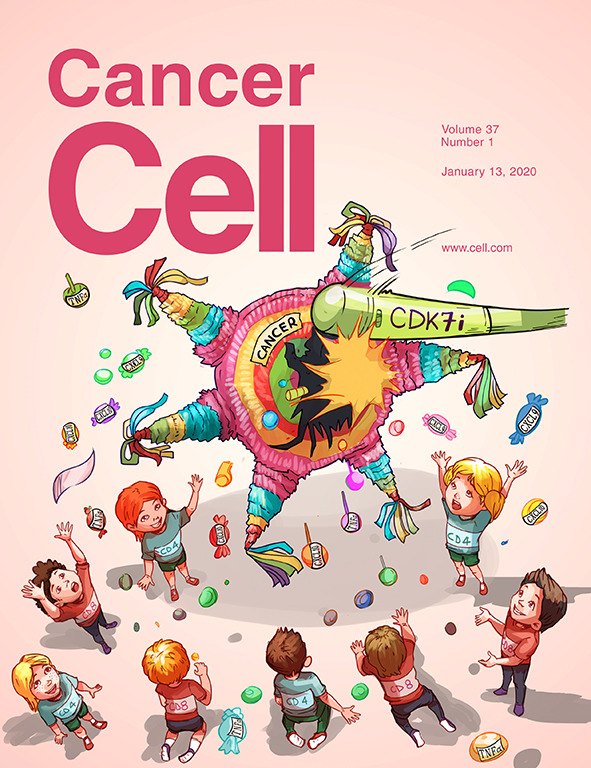非功能性胰腺神经内分泌肿瘤的蛋白质基因组学特征揭示了临床相关亚群
IF 44.5
1区 医学
Q1 CELL BIOLOGY
引用次数: 0
摘要
大多数胰腺神经内分泌肿瘤为非功能性胰腺神经内分泌肿瘤(NF-PanNETs),其远端转移发生率高,治疗选择有限。在这里,我们通过基因组、转录组、蛋白质组和磷蛋白质组的综合分析,对108个NF-PanNETs进行了全面的分子表征。蛋白质基因组学分析提供了NF-PanNETs基因组驱动改变的功能见解,揭示了MEN1条件敲除小鼠MEN1改变的潜在介质。基于机器学习的建模揭示了三蛋白特征作为独立的预后因素,并通过独立的外部队列验证。基于蛋白质组学和磷酸化蛋白质组学的分层鉴定出具有不同分子特征、免疫微环境和临床病理特征的四种亚型。使用患者来源的肿瘤类器官进行药物筛选,细胞周期蛋白依赖性激酶(CDK) 5和钙电压门控通道亚单位Alpha1 D (CACNA1D)分别作为普遍靶点和亚型特异性靶点,并使用异种移植模型进行体内验证。总之,我们的蛋白质基因组学分析说明了NF-PanNETs的全面分子景观,揭示了生物学见解和治疗脆弱性。本文章由计算机程序翻译,如有差异,请以英文原文为准。

Proteogenomic characterization of non-functional pancreatic neuroendocrine tumors unravels clinically relevant subgroups
The majority of neuroendocrine neoplasms in pancreas are non-functional pancreatic neuroendocrine tumors (NF-PanNETs), which exhibit a high occurrence of distant metastases with limited therapeutic options. Here, we perform a comprehensive molecular characterization of 108 NF-PanNETs through integrative analysis of genomic, transcriptomic, proteomic, and phosphoproteomic profiles. Proteogenomic analysis provides functional insights into the genomic driver alterations of NF-PanNETs, revealing a potential mediator of MEN1 alterations using Men1-conditional knockout mice. Machine-learning-based modeling uncovers a three-protein signature as an independent prognostic factor, which is validated by an independent external cohort. Proteomic and phosphoproteomic-based stratification identifies four subtypes with distinct molecular characteristics, immune microenvironments, and clinicopathological features. Drug screening using patient-derived tumor organoids identifies cyclin-dependent kinase (CDK) 5 and Calcium Voltage-Gated Channel Subunit Alpha1 D (CACNA1D) as ubiquitous and subtype-specific targets, respectively, with in vivo validation using xenograft models. Together, our proteogenomic analyses illustrate a comprehensive molecular landscape of NF-PanNETs, revealing biological insights and therapeutic vulnerabilities.
求助全文
通过发布文献求助,成功后即可免费获取论文全文。
去求助
来源期刊

Cancer Cell
医学-肿瘤学
CiteScore
55.20
自引率
1.20%
发文量
179
审稿时长
4-8 weeks
期刊介绍:
Cancer Cell is a journal that focuses on promoting major advances in cancer research and oncology. The primary criteria for considering manuscripts are as follows:
Major advances: Manuscripts should provide significant advancements in answering important questions related to naturally occurring cancers.
Translational research: The journal welcomes translational research, which involves the application of basic scientific findings to human health and clinical practice.
Clinical investigations: Cancer Cell is interested in publishing clinical investigations that contribute to establishing new paradigms in the treatment, diagnosis, or prevention of cancers.
Insights into cancer biology: The journal values clinical investigations that provide important insights into cancer biology beyond what has been revealed by preclinical studies.
Mechanism-based proof-of-principle studies: Cancer Cell encourages the publication of mechanism-based proof-of-principle clinical studies, which demonstrate the feasibility of a specific therapeutic approach or diagnostic test.
 求助内容:
求助内容: 应助结果提醒方式:
应助结果提醒方式:


